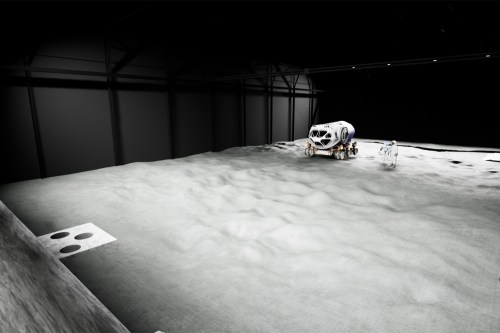
Before astronauts step foot in a rocket ship, they undergo grueling training in simulated environments meant to prepare them for the unforgiving space beyond Earth’s atmosphere. Everything is tested and accounted for, from the crew down to their tiniest tools.
Now, the European Space Agency (ESA) is developing an astronaut center in Cologne, Germany, where it will build a small replica of the surface of the moon. Dubbed Luna, the facility will be used to test new technologies and tools that future crews may find handy while exploring and establishing a base on our nearest cosmic neighbor.
“ESA wants to create a testbed for demonstrating and validating technologies and operational tools that will be needed for the human exploration of the moon,” Andreas Diekmann, an ESA project manager working on Luna, told Digital Trends. “ESA’s European Astronaut Centre in Cologne, where Luna will be established … already [has] experience with analog facilities and astronaut crew operations. This experience is currently focused on the [International Space Station] program, but we want to expand our expertise towards human exploration of the moon and, later, Mars.”
The Luna facility will combine a 1,000-square-meter (around 10,750-square-foot) artificial lunar habitat, powered by a solar energy system similar to what ESA thinks could be used in the future to power a moon base. Solar has been deemed the most sustainable energy option on the moon. As for the moon dust, ESA will source volcanic powder from 45 million-year-old eruptions of a nearby volcano.
Still in its concept stage, ESA is finalizing the design and blueprints of the facility. But once it’s complete, Luna will be used to help train astronauts and test the tech they will use. ESA plans to develop the Future Lunar Exploration Habitat — a moon base where astronauts will live and work — by the end of the year.
“The utilization of Luna will have a focus on testing technologies and operational tools required for the human exploration of the moon,” Diekmann said. “Examples are the collaboration of astronauts and robots, or the testing of tools for in-situ utilization of lunar resources.”
Diekmann added that they plan on installing a gravity offloading system, which would simulate the feeling of reduced gravity, so that astronauts can train in the conditions similar to the moon, which has just one-sixth Earth’s gravity.
Editors' Recommendations
- Juice spacecraft gears up for first ever Earth-moon gravity boost
- Watch the European Space Agency test the parachute for its new Mars rover
- European Space Agency wants to build a GPS network for the moon
- Chinese spacecraft carrying moon rocks begins its journey back to Earth
- NASA wants to start a gold rush in space, so it’s putting a bounty on moon dirt